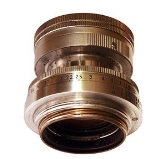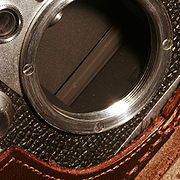
M39 lens mount
Encyclopedia
The M39 lens mount
is a screw thread
mounting system for attaching lenses to 35 mm cameras
, primarily rangefinder
(RF) Leicas. It is also the most common mount for Photographic enlarger lenses.
True Leica thread-mount (LTM) is 39 mm in width and has a thread of 26 turns-per-inch Whitworth
, approximately 0.977 mm. Whitworth threads in inches were then the norm in microscope manufacture, and Leitz was a major manufacturer of microscopes, so the tooling at the plant could easily accommodate the 1/26" size and the Whitworth thread. The Soviets in the 1930s produced their early FED cameras
in M39×1 (39 mm by 1 mm DIN
thread). Early Canon cameras also used a different M39 × 24 tpi thread mount, called "J-mount".
True LTM enjoys an optical registration
of 28.8 mm, though this does not matter for lenses used on bellows enlargers.
The Soviets later adopted the LTM mount for their Zenit
single-lens-reflex (SLR) cameras, though with the longer optical registration of 45.2 mm, required to allow the mirror room to flip out of the focal path when a picture was taken.
The mount was developed by Oscar Barnack at Leica to provide a system that would allow for the exchange of lenses on their new small film cameras (Leica Type 1 and Leica Type 2), as Zeiss Ikon had indicated that their forthcoming Contax rangefinder cameras would have interchangeable lenses. The LTM system was tested at the request of Leitz on lenses manufactured in small batches by Hugo Meyer in Germany and marketed with a run of Leitz cameras by A. O. Roth in London. The test marketing program was a success, so regular production with Leitz camera bodies and lenses was introduced on the Leica II
, and featured on the Leica Standard
and Leica III
.
Until the 1970s the 39 mm mount was the norm for exchangeable lenses in rangefinder camera
s. The high cost of quality lenses led to the dual use camera/enlarger of the lenses, hence the fact that enlarger
s also accept 39 mm lenses.
 Currently, Cosina
Currently, Cosina
in Japan — many of whose recent products are marketed under the Voigtländer
brand — and FED
in Ukraine continue to produce camera bodies using a true Leica thread-mount. These give amateurs the rare chance of having a very professional camera by combining a used Leica lens with an M39 body at a price well below a real Leica combination. On the other hand one has to be careful as there are some issues with some bodies not using the same focusing system. Adaptors are available to use M39 lenses with modern digital cameras, such as the Sony E mount.
Lens mount
A lens mount is an interface — mechanical and often also electrical — between a photographic camera body and a lens. It is confined to cameras where the body allows interchangeable lenses, most usually the single lens reflex type or any movie camera of 16 mm or higher gauge...
is a screw thread
Screw thread
A screw thread, often shortened to thread, is a helical structure used to convert between rotational and linear movement or force. A screw thread is a ridge wrapped around a cylinder or cone in the form of a helix, with the former being called a straight thread and the latter called a tapered thread...
mounting system for attaching lenses to 35 mm cameras
135 film
The term 135 was introduced by Kodak in 1934 as a designation for cartridge film wide, specifically for still photography. It quickly grew in popularity, surpassing 120 film by the late 1960s to become the most popular photographic film format...
, primarily rangefinder
Rangefinder camera
A rangefinder camera is a camera fitted with a rangefinder: a range-finding focusing mechanism allowing the photographer to measure the subject distance and take photographs that are in sharp focus...
(RF) Leicas. It is also the most common mount for Photographic enlarger lenses.
True Leica thread-mount (LTM) is 39 mm in width and has a thread of 26 turns-per-inch Whitworth
British Standard Whitworth
British Standard Whitworth is one of a number of imperial unit based screw thread standards which use the same bolt heads and nut hexagonal sizes, the others being British Standard Fine thread and British Standard Cycle...
, approximately 0.977 mm. Whitworth threads in inches were then the norm in microscope manufacture, and Leitz was a major manufacturer of microscopes, so the tooling at the plant could easily accommodate the 1/26" size and the Whitworth thread. The Soviets in the 1930s produced their early FED cameras
FED (camera)
The FED is a Soviet rangefinder camera, mass produced from 1934 until around 1990, and also the name of the factory that made it.FED is indirectly named after Felix Edmundovich Dzerzhinsky, founder of the Cheka...
in M39×1 (39 mm by 1 mm DIN
Deutsches Institut für Normung
is the German national organization for standardization and is that country's ISO member body. DIN is a Registered German Association headquartered in Berlin...
thread). Early Canon cameras also used a different M39 × 24 tpi thread mount, called "J-mount".
True LTM enjoys an optical registration
Flange focal distance
For an interchangeable lens camera, the flange focal distance of a lens mount system is the distance from the mounting flange to the...
of 28.8 mm, though this does not matter for lenses used on bellows enlargers.
The Soviets later adopted the LTM mount for their Zenit
Zenit (camera)
Zenit is a Russian camera brand manufactured by KMZ in the town of Krasnogorsk near Moscow since 1952 and by BelOMO in Belarus since the 1970s. The Zenit trademark is associated with 35mm SLR cameras...
single-lens-reflex (SLR) cameras, though with the longer optical registration of 45.2 mm, required to allow the mirror room to flip out of the focal path when a picture was taken.
The mount was developed by Oscar Barnack at Leica to provide a system that would allow for the exchange of lenses on their new small film cameras (Leica Type 1 and Leica Type 2), as Zeiss Ikon had indicated that their forthcoming Contax rangefinder cameras would have interchangeable lenses. The LTM system was tested at the request of Leitz on lenses manufactured in small batches by Hugo Meyer in Germany and marketed with a run of Leitz cameras by A. O. Roth in London. The test marketing program was a success, so regular production with Leitz camera bodies and lenses was introduced on the Leica II
Leica II
The Leica II is a rangefinder camera introduced by Leica in 1932. They were the first Leica cameras with an integrated rangefinder. Several models were produced over the years, in parallel with the Leica III series from 1933....
, and featured on the Leica Standard
Leica Standard
The Leica Standard, Model E was the fourth version to be launched from Ernst Leitz in Wetzlar, Germany. The concept was conceived by their employee Oscar Barnack in 1913 at which time two prototypes were built. However, it was not until 1924 that Leitz decided to go ahead with the concept and...
and Leica III
Leica III
The Leica III is a rangefinder camera introduced by Leica in 1933, and produced in parallel with the Leica II series. Several models were produced over the years, with significant improvements....
.
Until the 1970s the 39 mm mount was the norm for exchangeable lenses in rangefinder camera
Rangefinder camera
A rangefinder camera is a camera fitted with a rangefinder: a range-finding focusing mechanism allowing the photographer to measure the subject distance and take photographs that are in sharp focus...
s. The high cost of quality lenses led to the dual use camera/enlarger of the lenses, hence the fact that enlarger
Enlarger
An enlarger is a specialized transparency projector used to produce photographic prints from film or glass negatives using the gelatin silver process, or from transparencies.-Construction:...
s also accept 39 mm lenses.

Cosina
is a designer and manufacturer of cameras and lenses, and a glassmaker, based in Nakano, Nagano Prefecture, Japan.-History:Cosina is the successor to Nikō , a company set up as a manufacturer oflenses in 1959...
in Japan — many of whose recent products are marketed under the Voigtländer
Voigtländer
Voigtländer is an optical company founded by Johann Christoph Voigtländer in Vienna in 1756 and is thus the oldest name in cameras. It produced the Petzval photographic lens in 1840, and the world's first all-metal daguerrotype camera in 1841, also bringing out plate cameras shortly afterwards...
brand — and FED
FED (camera)
The FED is a Soviet rangefinder camera, mass produced from 1934 until around 1990, and also the name of the factory that made it.FED is indirectly named after Felix Edmundovich Dzerzhinsky, founder of the Cheka...
in Ukraine continue to produce camera bodies using a true Leica thread-mount. These give amateurs the rare chance of having a very professional camera by combining a used Leica lens with an M39 body at a price well below a real Leica combination. On the other hand one has to be careful as there are some issues with some bodies not using the same focusing system. Adaptors are available to use M39 lenses with modern digital cameras, such as the Sony E mount.
Sources
- Dante Stella Standard: GOST 10332-63 Standard: GOST 10332-72
- Marc James Small. NON-LEITZ LEICA THREAD-MOUNT LENSES: A 39mm DIVERSITY. Rita Wittig, 1995.

